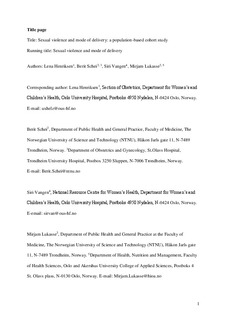| dc.contributor.author | Henriksen, Lena | |
| dc.contributor.author | Schei, Berit | |
| dc.contributor.author | Vangen, Siri | |
| dc.contributor.author | Lukasse, Mirjam | |
| dc.date.accessioned | 2015-01-20T13:38:17Z | |
| dc.date.accessioned | 2015-02-09T14:47:09Z | |
| dc.date.available | 2015-01-20T13:38:17Z | |
| dc.date.available | 2015-02-09T14:47:09Z | |
| dc.date.issued | 2014 | |
| dc.identifier.citation | BJOG: an International Journal of Obstetrics and Gynaecology 2014, 121(10):1237-1244 | nb_NO |
| dc.identifier.issn | 1471-0528 | |
| dc.identifier.uri | http://hdl.handle.net/11250/275675 | |
| dc.description | This is the author’s final, accepted and refereed manuscript to the article. | nb_NO |
| dc.description.abstract | Objective: This study aimed to explore the association between sexual violence and mode of delivery.
Design: National cohort study. Setting: Women presenting for routine ultrasound examinations were recruited to the Norwegian Mother and Child Cohort Study (MoBa) between 1999-2008.
Population: 74 059 pregnant women. Methods: Sexual violence was self-reported during pregnancy using postal questionnaires. Mode of delivery, other maternal birth outcomes and covariates were retrieved from the Medical Birth Registry of Norway. Risk estimations were performed using multivariable logistic regression analysis. Main Outcome Measures: Mode of delivery and selected maternal birth outcomes. Results: Of 74 059 women, 18.4% reported a history of sexual violence. A total of 10% had an operative vaginal birth, 4.9% elective caesarean section (CS), and 8.6% had an emergency CS. Severe sexual violence (rape) was associated with elective CS, AOR 1.56 (95% CI 1.18-2.05) for nulliparous women and 1.37 (1.06-1.76) for multiparous women. Those exposed to moderate sexual violence had a higher risk of emergency CS, AOR 1.31 (1.07-1.60) and 1.41 (1.08-1.84) for nulli- and multiparous women, respectively. No association was found between sexual violence and operative vaginal birth, except for a lower risk among multiparous women reporting mild sexual violence, AOR 0.73 (0.60-0.89). Analysis of other maternal outcomes showed a reduced risk of episiotomy for women reporting rape and a higher frequency of induced labour.
Conclusions: Women with a history of rape had higher odds of elective CS and induction and significantly fewer episiotomies. | nb_NO |
| dc.language.iso | eng | nb_NO |
| dc.publisher | Wiley Online Library | nb_NO |
| dc.title | Sexual violence and mode of delivery: a population-based cohort study | nb_NO |
| dc.type | Journal article | nb_NO |
| dc.type | Peer reviewed | en_GB |
| dc.date.updated | 2015-01-20T13:38:17Z | |
| dc.source.pagenumber | 1237-1244 | nb_NO |
| dc.source.volume | 121 | nb_NO |
| dc.source.journal | BJOG: An International Journal of Obstetrics and Gynaecology | nb_NO |
| dc.source.issue | 10 | nb_NO |
| dc.identifier.doi | 10.1111/1471-0528.12923 | |
| dc.identifier.cristin | 1140141 | |
| dc.description.localcode | Forfatterens aksepterte fagfellevurderte versjon/postprint. Locked until 2015-06-18 due to copyright restriction.© 2014 Royal College of Obstetricians and Gynaecologists | nb_NO |

